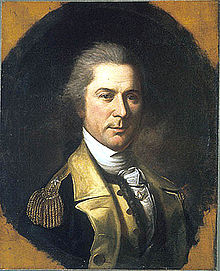Otho Williams
| Otho Holland Williams | |
|---|---|

Painting of Williams in 1784 by Charles Willson Peale
|
|
| Born | March 1, 1749 Prince George's County, Maryland |
| Died | July 15, 1794 (aged 46) |
| Allegiance |
|
| Service/ |
Continental Army |
| Rank |
|
| Unit |
|
| Commands held |
|
| Battles/wars | |
| Other work | 1st Commissioner of the Port of Baltimore |
Otho Holland Williams (March 1, 1749 – July 15, 1794) was a Continental Army officer from Maryland in the American Revolutionary War. He participated in many battles throughout the war in the New York, New Jersey and Southern theaters, eventually ending his career as a Brigadier General.
Born in rural Prince George's County, Maryland, Williams spent his childhood on Springfield Farm near present-day Williamsport. He was orphaned at age thirteen and was put in the care of his father's brother-in-law, Mr. Ross. Williams took an apprenticeship under Mr. Ross and studied his profession in the Clerk's office of Frederick, eventually taking charge of the office. At age eighteen, Williams moved to Baltimore and undertook a similar trade. Williams returned to Frederick in 1774 and entered into a commercial life.
In response to Congress's call for soldiers at the outbreak of the American Revolutionary War in the spring of 1775, Williams joined a Continental Army rifle unit as a commissioned officer. Soon thereafter, he and his unit marched off to the Siege of Boston. Seeing his first significant combat action in late 1776 at the Battle of Fort Washington, Williams was captured by the British and imprisoned in New York. He was released in early 1778 and returned to the Continental Army as colonel of the 6th Maryland Regiment, a position he had acquired during his captivity. From thereafter, Williams led his regiment through much of the southern campaign, most notably in the battles of Camden, Guilford Court House, and Eutaw Springs. Near the end of the War, Williams was sent by his commanding officer General Greene with documents to Congress and was promoted to brigadier general in 1782.
...
Wikipedia
